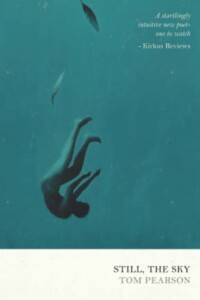Title: Still, the Sky
Author: Tom Pearson
Publisher: Independently published
ISBN: 979-8430895471
Pages: 130
Genre: Poetry
Reviewed by: David Allen
Pacific Book Review
 Orpheus was a celebrated poet, musician and prophet in ancient Greek mythology. It is rare in this time of social media, information technology, and thought franchises to find an Orphic voice that puts all that to rest. Author Tom Pearson, the creator of Still, the Sky, is a brilliant scholar, artist, and poet who brings to the page a veritable treasure trove of poetry and art, illustrating the somber and beautiful stanzas of his poetry.
Orpheus was a celebrated poet, musician and prophet in ancient Greek mythology. It is rare in this time of social media, information technology, and thought franchises to find an Orphic voice that puts all that to rest. Author Tom Pearson, the creator of Still, the Sky, is a brilliant scholar, artist, and poet who brings to the page a veritable treasure trove of poetry and art, illustrating the somber and beautiful stanzas of his poetry.
These stanzas are wistful, elegiac, invoking the gods, the goddesses, and celebrating the primacy of nature and the elements. Pearson borrows liberally from legend and classical lore, generously gifting readers with his redoubtable knowledge of the pantheons and the old languages.
These lines from Ovid set the tone for the book:
Homesick for homeland, Daedalus despised Crete
And his long exile there, but the sea held him.
“Though Minos blocks escape by land or water,”
Daedalus said, “still, the sky is before us,
And that’s the way we’ll go. Minos’ dominion
Does not include the air.” He turned his thinking
Toward unknown arts, changing the laws of nature.
Ovid, and Pearson, refer here to man’s sure avenue of escape (and safety): the sky, the empyrean, the dominion of song and lyric and beauty.
Constant threads run through the poems. One of them is the mythic Icarus, whose ‘hubris’ led him to defy his father’s warning to not fly too close to the sun. The other is Asterion, the Minotaur of legend who lay in wait in the center of the labyrinth for the hero Theseus. These themes are played out magnificently in the accompanying illustrations, which are photos of artifacts, ecofacts (= ecological artifacts) and art assembled and installed by Pearson for various multimedia projects, including gallery exhibitions.
The color illustrations are every bit as classy as the poems, featuring shells, labyrinths and mazes in wax, heads of deities, matchsticks, eggs, and swirls of matter defying description but resembling primordial galaxies or whorls of creation.
Clearly a poet – a poet of words, and a visual poet – is at work here. The poems, the arcane subject matter and classical references, are reminiscent of the best of Robert Graves and Ezra Pound. The visual art, intensely evocative of archetypes, past lives, avatars to come, is formally reminiscent of the boxes and dioramas of Joseph Cornell.
What a cornucopia! What a feast for the eye, the heart, the spirit…some readers may be daunted by the intellectual scope of this work, but an active read of this awe-inspiring book, aided and abetted by occasional recourse to the dictionary, is well worth the investment of effort. It’s not every day that, winged like Icarus, we can take to the sky. Pearson plucks the lyre of the page, bringing us the music of the spheres.


